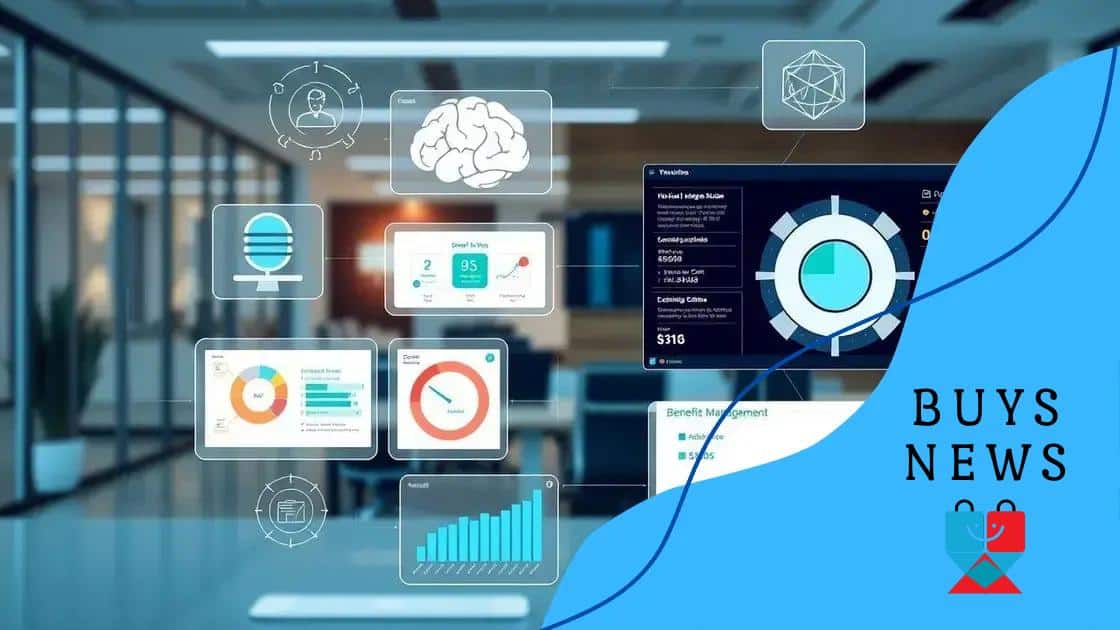AI-enhanced benefits administration transforms HR practices

AI-enhanced benefits administration leverages technology to streamline processes, personalize offerings, and improve employee engagement, ensuring a more efficient and satisfying benefits experience.
AI-enhanced benefits administration is reshaping how organizations manage employee benefits, making processes more efficient and user-friendly. Have you ever wondered how AI can make a difference in your HR strategies?
Understanding AI-enhanced benefits administration
Understanding AI-enhanced benefits administration is crucial for modern businesses looking to streamline their HR processes. This innovative approach leverages technology to make benefits management easier for both employers and employees.
What is AI-enhanced benefits administration?
This concept involves using artificial intelligence to optimize the way employee benefits are managed. By automating various aspects of benefits administration, organizations can reduce errors and save time. It allows HR teams to focus more on strategic challenges rather than getting bogged down in paperwork.
Key features of AI-enhanced benefits administration
- Automation of routine tasks such as enrollment and changes.
- Personalized employee experiences through AI-driven recommendations.
- Real-time data analytics to inform decision-making.
- Improved compliance with benefits regulations.
Furthermore, the use of AI in this context leads to better engagement. Employees appreciate quicker responses to their inquiries and more tailored benefits options. The advanced technology can predict what benefits upgrades or options might appeal to specific groups, leading to higher satisfaction rates.
AI also enables organizations to compile and analyze data more effectively. With detailed insights into employee preferences and usage patterns, companies can refine their benefits offerings. The goal is to create a package that resonates well with employees while ensuring cost-effectiveness for the organization.
Overall, understanding AI-enhanced benefits administration can empower businesses to leverage technology for a more efficient and satisfying benefits experience. By taking advantage of AI tools, human resources departments can transform their operations and foster a culture of support and engagement.
How AI can improve benefits management
AI has the potential to significantly improve benefits management by automating processes and providing valuable insights. This allows organizations to manage employee benefits more efficiently and effectively.
Streamlining administrative tasks
With AI, many administrative tasks involved in benefits management can be automated. This includes tasks like processing enrollments, managing changes, and handling inquiries. Automation leads to faster service for employees and reduces the workload on HR teams.
Personalized benefits offerings
Another way AI enhances benefits management is through personalization. AI analyzes employee data to suggest benefits that suit individual preferences. When employees receive offers tailored to their needs, they are more likely to engage with the benefits available to them.
- Customized health plans based on individual health data.
- Retirement saving options aligned with employee goals.
- Wellness programs tailored to promote overall health.
- Flexible spending accounts that adjust to personal financial situations.
This personalization fosters a sense of care and engagement among employees, promoting overall satisfaction. When employees feel valued through customized offerings, their loyalty to the organization increases.
Additionally, AI can analyze data to identify trends and predict future needs. This helps organizations to proactively adjust their benefits strategies. By understanding employee preferences, HR departments can modify offerings to match what employees genuinely want.
Companies can also leverage AI to ensure compliance with legal and regulatory requirements. AI tools can automatically track changes in legislation and alert HR teams to necessary adjustments. This reduces the risk of non-compliance and helps mitigate potential penalties.
Incorporating AI into benefits management ultimately leads to a more efficient, employee-centric approach. With these advancements, organizations can create a positive working environment that not only attracts talent but also retains it.
Key technologies in AI-driven benefits solutions

The landscape of AI-driven benefits solutions is shaped by several key technologies that enhance how organizations manage employee benefits. These technologies not only streamline processes but also improve the overall experience for both HR teams and employees.
Machine Learning
Machine learning is a powerful component of AI that helps in analyzing vast amounts of data. By identifying patterns, it can predict employee needs and preferences in benefits. This predictive capability allows HR departments to tailor benefits packages that are more aligned with what employees value.
NLP (Natural Language Processing)
Natural Language Processing (NLP) facilitates better communication between employees and HR systems. Employees can inquire about benefits or policies using simple language, and AI can interpret those requests accurately. This technology helps in creating chatbots that provide instant responses, making it easier for employees to get information.
- Enhanced employee engagement through conversational interfaces.
- Quick answers to common benefits-related questions.
- Reduced administrative burden on HR staff.
Additionally, NLP can analyze employee feedback and sentiment, allowing organizations to make data-driven improvements to their benefits offerings. This feedback loop is crucial for staying relevant and responsive to employee concerns.
Another significant technology used is predictive analytics. This involves analyzing historical data to foresee future trends. By leveraging predictive analytics, companies can optimize their benefits strategies by anticipating changes in employee demographics or preferences.
Automation Tools
Automation tools are essential in streamlining administrative tasks involved in benefits management. These tools can handle tasks such as enrollment, claims processing, and compliance checks with minimal human intervention. Automation not only speeds up these processes but also reduces errors, ensuring a smooth operation.
Cutting-edge technologies such as blockchain are also emerging in benefits solutions. Blockchain can enhance security and transparency in the management of benefits data. By using decentralized ledgers, organizations can ensure that transactions are secure and accessible only to authorized personnel.
Incorporating these key technologies into AI-driven benefits solutions allows organizations to provide a seamless benefits experience that meets the needs of today’s workforce. As technology continues to evolve, so will the possibilities for enhancing benefits management.
Real-world examples of AI in benefits administration
Real-world examples of AI in benefits administration illustrate the transformative power of technology in managing employee benefits effectively. Companies across various sectors are deploying AI solutions to enhance their processes and improve employee satisfaction.
Case Study: Large Tech Company
A well-known tech giant has integrated AI chatbots into its benefits administration system. These chatbots answer employee questions regarding health plans, retirement options, and other benefits. This implementation has reduced the volume of calls to the HR department, allowing staff to focus on more complex issues.
Case Study: Financial Services Firm
A leading financial services firm uses machine learning to analyze employee benefits usage patterns. By understanding how employees interact with their benefits, the firm can tailor offerings to better meet their needs. This proactive approach has led to an increase in employee engagement and satisfaction with the benefits package.
- Customized health insurance options based on usage data.
- Predictive analytics to identify potential future needs.
- Timely updates on benefits based on changing regulations.
By harnessing the power of data, this financial services firm has been able to ensure its benefits offerings remain relevant and useful to its employees.
Another example can be seen in a retail company that employs AI-driven tools to streamline benefits enrollment during onboarding. The system simplifies the process, guiding new hires through their options step by step. This approach has decreased enrollment errors significantly and improved the overall experience for new employees.
Case Study: Healthcare Provider
A healthcare provider utilized AI to enhance its benefits communications. The technology enables personalized messaging to employees based on their health needs and preferences. By tailoring communications, the provider has seen better engagement rates with wellness programs.
Overall, these real-world examples highlight the various ways AI in benefits administration is improving efficiency and employee satisfaction. As more organizations adopt these technologies, the potential for innovation in HR practices continues to grow.
Challenges and considerations for implementation
Implementing AI-enhanced benefits administration comes with its own set of challenges and considerations. Organizations must navigate these hurdles to successfully integrate AI into their HR processes.
Data Privacy and Security
One of the primary concerns is data privacy and security. With sensitive employee information being processed by AI systems, it is crucial to ensure that data is protected against breaches. Organizations need to establish clear data governance policies and comply with regulations, such as GDPR.
Integration with Existing Systems
Another challenge is integrating AI solutions with existing HR systems. Many companies have legacy systems that may not be compatible with new AI technologies. Organizations need to evaluate their current technology stack and plan for a smooth transition, which may involve significant investment.
- Assessing compatibility of legacy systems with new AI tools.
- Investing in necessary infrastructure upgrades.
- Planning for training and change management for HR staff.
Training is also a significant consideration. HR personnel must be equipped to work with AI technologies effectively. Organizations should offer comprehensive training programs to ensure that staff understands how to use new tools and interpret AI-generated insights accurately.
Employee Acceptance
Additionally, employee acceptance of AI in benefits administration can be a barrier. Some employees may have concerns about how AI will impact their jobs or how their data is used. To address these issues, organizations must communicate transparently about the benefits of AI and involve employees in the implementation process. This will help foster trust and buy-in from the workforce.
Finally, organizations need to consider the cost of implementing AI solutions. While the long-term benefits can be substantial, the initial investment can be daunting. Companies should conduct a cost-benefit analysis to ensure that the anticipated ROI justifies the investment. This analysis can help prioritize which AI features are most essential and which can be phased in over time.
By proactively addressing these challenges and considerations, organizations can better position themselves for successful implementation of AI-enhanced benefits administration. The potential for improved efficiency and employee satisfaction makes these efforts worthwhile.
FAQ – Frequently Asked Questions about AI-enhanced Benefits Administration
What are the main advantages of using AI in benefits administration?
AI streamlines benefits processes, personalizes employee offerings, and provides valuable insights that can improve overall employee satisfaction.
How can organizations ensure data privacy when using AI?
Organizations should implement strong data governance policies, comply with relevant regulations, and use secure technologies to protect employee information.
What challenges do businesses face when implementing AI solutions?
Common challenges include data security concerns, integration with existing systems, ensuring employee acceptance, and the cost of implementation.
How can companies encourage employee acceptance of AI in benefits administration?
Transparent communication about the benefits of AI and involving employees in the implementation process can help foster trust and acceptance.





